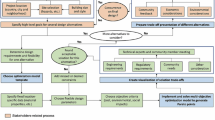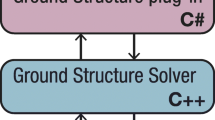Abstract
Building height is of crucial importance in architectural design. In this paper, we provide an integer optimization model to determine the number of stories in high-rise buildings. This model relies on the analysis of profit cash flow over time. The practical insights of our proposal are illustrated through a real-world case study involving a hypothetical development in Punta del Este, Uruguay. A sensitivity analysis of the parameters that exert a more significant impact on the optimal height is studied as well.



Similar content being viewed by others
Data Availability
No datasets were generated or analyzed during the current study.
Code Availability
The code is displayed in the Appendix.
Notes
Specifically, this pattern is more pronounced in markets where the credit or mortgage system for purchasing dwellings is not well-developed.
This approach is widely employed in decision analytical studies; for reference, see Clemen and Reilly [18].
We are assuming that the developer is risk neutral, but other preferences for risk could be used in this model (see Egozcue et al. [41]).
For insights into incentives related to this type of restriction and their impact on decision analysis, interested readers are referred to Thanassoulis et al. [42].
It is worth noting that our model offers flexibility, allowing for the consideration of other premium functional forms.
For guidance on creating a tornado diagram and conducting sensitivity analysis, one can refer to the detailed steps outlined by Eschenbach [47].
This approximation arises because we have defined the revenue collection period in months.
References
Clark WC, Kingston JL (1930) The skyscraper, a study in the economic height of modern office buildings. New York and Cleveland: American Institute of Steel Construction. Retrieved from https://archive.org/details/in.ernet.dli.2015.169080. (Accessed 23 Oct 2023)
Büttler HJ, Beckmann MJ (1980) Design parameters in housing construction and the market for urban housing. Econometrica, pp 201–225. https://doi.org/10.2307/1912025
Pollard R (1980) Topographic amenities, building height, and the supply of urban housing. Reg Sci Urban Econ 10(2):181-199. [SPSurl13urlSPS]
Titman S (1985) Urban land prices under uncertainty. Am Econ Rev 75(3):505–514. Retrieved from [SPSurl5urlSPS] (Accessed online 23 Oct 2023)
Gat D (1995) Optimal development of a building site. J Real Estate Financ Econ 11:77–84. https://doi.org/10.1007/bf01097938
Tan W (1999) Construction cost and building height. Constr Manag Econ 17(2):129-132. [SPSurl8urlSPS]
Chau KW, Wong SK, Yau Y, Yeung AKC (2007) Determining optimal building height. Urban Stud 44(3):591–607. https://doi.org/10.1080/00420980601131902
Gat D (2015) Notes on the economics of tall buildings. Working Paper, The Center for Urban and Regional Studies, Technion-Israel Institute of Technology. Retrieved from https://scholar.google.com/citations?view_op=view_citation &hl=en &user=YX8FJq0AAAAJ &citation_for_view=YX8FJq0AAAAJ:4JMBOYKVnBMC (Accessed online 23 Oct 2023)
Ben-Shahar D, Deng Y, Sulganik E (2009) Property appraisal in high-rises: a cooperative game theory approach. Int J Prod Res 18(1):25–33. https://doi.org/10.1016/j.jhe.2009.02.001
Lu J (2023) The economics of China’s between-city height competition: a regression discontinuity approach. Reg Sci Urban Econ 100:103881. [SPSurl20urlSPS]
Picken DH, Ilozor BD (2003) Height and construction costs of buildings in Hong Kong. Constr Manag Econ 21(2):107-111. [SPSurl15urlSPS]
Barr J (2012) Skyscraper height. J Real Estate Finance Econ 45(3):723–753. https://doi.org/10.1007/s11146-010-9274-z
Szóstak M (2022) Best fit of cumulative cost curves at the planning and performed stages of construction projects. Buildings 123:565-573. [SPSurl9urlSPS]
Al-Saggaf A, Nasir H, Hegazy T (2020) An analytical hierarchy process-based system to evaluate the life-cycle performance of buildings at early design stage. J Build Eng 31:101364. https://doi.org/10.1016/j.jobe.2020.101364
Azizi M, Talatahari S, Basiri M, Shishehgarkhaneh MB (2022) Optimal design of low-and high-rise building structures by Tribe-Harmony Search algorithm. Decision Anal J 3:100067. https://doi.org/10.1016/j.dajour.2022.100067
Nouhi B, Jahani Y, Talatahari S, Gandomi AH (2022) A swarm optimizer with modified feasible-based mechanism for optimum structure in steel industry. Decision Anal J 5:100129. [SPSurl16urlSPS]
Iannantuono A, Hare W, Lucet Y (2023) Optimization with regularization to create sensible vertical alignments in road design. Decision Anal J 6:100183. https://doi.org/10.1016/j.dajour.2023.100183
Clemen RT, Reilly T (2014) Making hard decisions with DecisionTools 3rd Edition. Cengage Learning. Retrieved from https://www.cengagebrain.com.mx/shop/isbn/9780538797573 (Accessed 23 Oct 2023)
Ahlfeldt GM, Barr J (2022) The economics of skyscrapers: a synthesis. J Urban Econ 129:103419. https://doi.org/10.1016/j.jue.2021.103419
Ahlfeldt GM, McMillen DP (2018) Tall buildings and land values: height and construction cost elasticities in Chicago, 1870–2010. Rev Econ Stat 100(5):861–875. https://doi.org/10.1162/rest_a_00734
Meese R, Wallace N (2003) House price dynamics and market fundamentals: the Parisian housing market. Urban Stud 40(5-6):1027-1045. [SPSurl18urlSPS]
Wong SK, Chau KW, Yau Y, Cheung AKC (2011) Property price gradients: the vertical dimension. J Hous Built Environ 26(1):33-45. [SPSurl2urlSPS]
Guo X, Egozcue M, Wong WK (2020) Production theory under price uncertainty for firms with disappointment aversion. Int J Prod Res. https://doi.org/10.1080/00207543.2020.1733699
Chakri P, Pratap S, Gouda SK (2023) An exploratory data analysis approach for analyzing financial accounting data using machine learning. Decision Anal J 7:100212. https://doi.org/10.1016/j.dajour.2023.100212
Lahmiri S, Bekiros S, Avdoulas C (2023) A comparative assessment of machine learning methods for predicting housing prices using Bayesian optimization. Decision Anal J 6:100166. [SPSurl21urlSPS]
Wheaton W, Simonton W (2007) The secular and cyclic behavior of “True” construction costs. J Real Estate Res 29(1):1-26. [SPSurl3urlSPS]
Mann T (1992) Building economics in Architects New York: van Nostrand Reinhold. Retrieved from [SPSurl19urlSPS] (Accessed online 29 Mar 2024)
Abanda FH, Chia EL, Enongene KE, Manjia MB, Fobissie K, Pettang UJMN, Pettang C (2022) A systematic review of the application of multi-criteria decision-making in evaluating Nationally Determined Contribution projects. Decision Anal J 100140. https://doi.org/10.1016/j.dajour.2022.100140
Borgonovo E, Plischke E (2016) Sensitivity analysis: a review of recent advances. Eur J Oper Res 248(3):869–887. https://doi.org/10.1016/j.ejor.2015.06.032
Borgonovo E (2017) Sensitivity analysis. An Introduction for the Management Scientist International Series in Operations Research and Management Science Cham, Switzerland: Springer. https://doi.org/10.1007/978-3-319-52259-3
Razavi S, Jakeman A, Saltelli A, Prieur C, Iooss B, Borgonovo E, Maier HR (2021) The future of sensitivity analysis: an essential discipline for systems modeling and policy support. Environ Model Softw 137:104954. [SPSurl12urlSPS]
Borgonovo E, Rabitti G (2023) Screening: from tornado diagrams to effective dimensions. Eur J Oper Res 304(3):1200–1211. https://doi.org/10.1016/j.ejor.2022.05.003
Seeley IH (1996) Building economics: appraisal and control of building design cost and efficiency. Macmillan International Higher Education. Retrieved from [SPSurl10urlSPS] (Accessed online 23 Oct 2023)
Mosey G, Deal B (2022) Measuring the economic premium for height. CTBUH J (2). Retrieved from [SPSurl17urlSPS]. (Accessed on 29 Mar 2024)
Xiao Y, Hui EC, Wen H (2019) Effects of floor level and landscape proximity on housing price: a hedonic analysis in Hangzhou, China. Habitat Intl 87:11-26. [SPSurl1urlSPS]
Wen H, Gui Z, Zhang L, Hui EC (2020) An empirical study of the impact of vehicular traffic and floor level on property price. Habitat Intl 97:102132. [SPSurl4urlSPS]
Rosenthal SS, Strange WC, Urrego JA (2022) JUE insight: are city centers losing their appeal? Commercial real estate, urban spatial structure, and COVID-19. J Urban Econ 127:103381.[SPSurl11urlSPS]
Hwang SIM, Ma L (2023) Top-floor discounts in residential buildings: evidence from South Korea. Real Estate Economics 51(2):441–469. https://doi.org/10.1111/1540-6229.12409
Picken D, Ilozor B (2015) The relationship between building height and construction costs. Design Economics for the Built Environment: Impact of Sustainability on Project Evaluation, p 47-60. [SPSurl14urlSPS]
Castro Miranda SL, Del Rey Castillo E, Gonzalez V, Adafin J (2022) Predictive analytics for early-stage construction costs estimation. Buildings 12(7):1043. https://doi.org/10.3390/buildings12071043
Egozcue M, García LF, Zitikis R (2023) The slicing method: determining insensitivity regions of probability weighting functions. Comput Econ 61(4):1369–1402. https://doi.org/10.1007/s10614-022-10252-8
Thanassoulis E, Blake C, Parthasarathy S (2022) Implicit and explicit incentives within economic regulation. Decision Anal J 4:100099. [SPSurl7urlSPS]
INE (2022) Boletín Técnico: Índice Costo de la Construcción, Uruguay. Retrieved from https://www5.ine.gub.uy/documents/Estad
The R Project for Statistical Computing (2023) Retrieved from [SPSurl6urlSPS] Accessed online on 31 Mar 2024
INE (2023) Boletín Técnico: Indicadores de Actividad Inmobiliaria (IAI). Mercado de Compraventa enero 2017 - junio 2023. Retrieved from https://www3.ine.gub.uy/boletin/compraventa_2022.html (Accessed on 2023-09-29)
KPMG (2023) Cost of capital study 2023. Retrieved from [SPSurl22urlSPS] (Accessed 30 Mar 2024)
Eschenbach TG (2006) Constructing tornado diagrams with spreadsheets. Eng Econ 51(2):195–204. https://doi.org/10.1080/00137910600695676
Funding
There is no special funding for this work.
Author information
Authors and Affiliations
Contributions
Martin Egozcue wrote the whole work.
Corresponding author
Ethics declarations
Ethics Approval
Not applicable.
Consent to Participate
Not applicable.
Consent for Publication
Not applicable.
Competing Interests
The authors declare no competing interests
Additional information
Publisher's Note
Springer Nature remains neutral with regard to jurisdictional claims in published maps and institutional affiliations.
Appendix
Appendix
To facilitate efficient computation of the optimal building height, we present a concise R code for the base-case scenario. This code leverages user-specified model parameters through well-defined functions to determine the number of floors that maximizes the project’s net present value (NPV). The code’s design allows for easy modification of revenue and cost functions and base-case assumptions, enabling users to explore various financial scenarios and their impact on the optimal building height. This facilitates efficient exploration of a range of financial scenarios and their corresponding optimal building. For the sake of simplifying notation in R, “a” replaces \(\nu \), “b” replaces \(\theta \), “e” replaces \(\rho \), “f” replaces \(\gamma \), and “g” replaces \(\delta \).

Rights and permissions
Springer Nature or its licensor (e.g. a society or other partner) holds exclusive rights to this article under a publishing agreement with the author(s) or other rightsholder(s); author self-archiving of the accepted manuscript version of this article is solely governed by the terms of such publishing agreement and applicable law.
About this article
Cite this article
Egozcue, M. An Integer Optimization Approach for Determining Building Height. Oper. Res. Forum 5, 56 (2024). https://doi.org/10.1007/s43069-024-00335-7
Received:
Accepted:
Published:
DOI: https://doi.org/10.1007/s43069-024-00335-7




